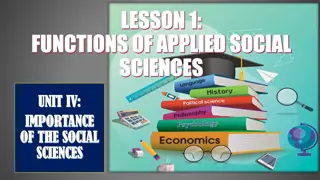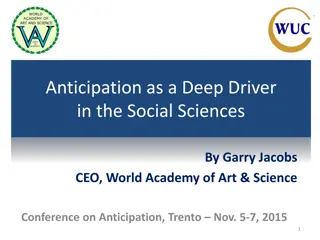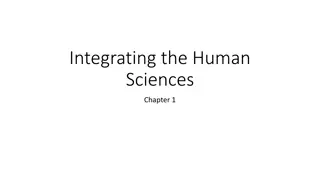Understanding Development in Social Sciences - Grade 9 Curriculum
Explore the concept of development in social sciences for Grade 9 learners, focusing on the definition of development, its significance, and ways to measure it using indicators like HDI. The content aims to lay the foundation for further studies in Geography.
Download Presentation

Please find below an Image/Link to download the presentation.
The content on the website is provided AS IS for your information and personal use only. It may not be sold, licensed, or shared on other websites without obtaining consent from the author. Download presentation by click this link. If you encounter any issues during the download, it is possible that the publisher has removed the file from their server.
E N D
Presentation Transcript
SOCIAL SCIENCES CONTENT Senior Phase Grade 9 Developed by: Nomvula Nxumalo 1
WHAT DRIVES GDE Vision Every learner feels valued and inspired in DIF TERM 1 2016 our innovative education system Mission We are committed to provide functional and modern schools that enable quality teaching and learning to protect and promote the right of every learner to quality, equitable and relevant education
THE CONCEPT OF DEVELOPMENT DEFINITION OF DEVELOPMENT Development means different things to different people. Development can be defined as the systematic use of scientific and technical knowledge to meet specific objectives or requirements. It is an event constituting a new stage in a changing situation. Development means the improvement of the country s economic and social conditions as a result of good management of natural and human resources. This creates wealth and improves the quality of life for people living in such areas.
OBJECTIVE OF THE LESSON To make sure that grade 9 learners know and understand development as per CAPS document. This lays part of the foundation for grade 11 Geography.
THE CONCEPT OF DEVELOPMENT Development can be well defined by comparing the level of development between countries or regions and refer to developed and developing countries. Development is a comprehensive societal process to move the underdeveloped nations from their state of economic backwardness and slow sociocultural change. Development results to a dynamic state characterized by sustained economic growth, sociocultural and political transformation that improves the quality of life of all members of society.
THE CONCEPT OF DEVELOPMENT Development is about changing the lives of people. Development involves every aspect of society, markets, governments, NGOs, cooperatives, and non-profit institutions.
WAYS TO MEASURE DEVELOPMENT Development is measured by using indicators. Indicator is a factor or aspect which can be measured and which gives one an idea about what the country is like economically, social and environmentally. HDI is the best measure of development as it takes into account both economic and social factors. However there are many other measures of development that can be used. The examples of each of these indicators are outlined below.
SOCIAL INDICATORS Social indicators include: Levels of education and literacy rate. Quality of life (HDI- Human Development Index). Gender Inequality Access to basic services such as water, electricity and clinics Diseases
ECONOMIC INDICATORS Economic indicators includes: GDP ( Gross Domestic Product) GNP (Gross National Product) GNP per capita Poverty Economic structure Balance of trade Living standards
MEASURE OF DEVELOPMENT Measure of development Description The percentage of people who have access to safe, clean water. Access to safe water The number of live births per 1,000 people. Birth rates are often high in a less developed country. Birth rate The number of deaths per 1,000 people. High death rates can indicate a less developed country. Death rate Gross national income per person. The value of a country's income, divided by the number of people in that country. GNI per capita The number of babies who don't survive to the age of 1 per 1,000 live births. Infant mortality rate Life expectancy The average age that a person may live to. Literacy rate The percentage of adults who can read and write. A ratio to show the number of people per doctor. A lower ratio can indicate a richer country. People per doctor
HUMAN DEVELOPMENT INDEX (HDI) Development is measured using the Human Development Index (HDI)). HDI is calculated by the United Nations. It measures average life expectancy, level of education and income for each country in the world. Each country is given a score between 0 and 1 - the closer a country gets to 1, the more developed it is.
EXPLANATION OF FIRST, SECOND AND THIRD WORLD The classification of countries refers to the manner in which countries achieved development. First world These countries received development by capitalist means or through market economy. Second world Countries received development by socialist means and state control. Third world Had not adopted either means these countries were still developing and poor.
THE NORTH-SOUTH DIVIDE & BRANDT DIVISION The Brandt division is an imaginary line which separates the richer and poor countries based on wealth. The Brandt line does not follow the equator which separates north and south.
POOR LESS THIRD WORLD ECONOMICALLY DEVELOPED (LED) DEVELOPING COUNTRIES NON- SOUTH INDUSTRIALISED COUNTRIES LOW INCOME
FIRST WORLD MORE HIGH INCOME ECONOMICALLY DEVELOPED (MED) DEVELOPED COUNTRIES RICH NORTH INDUSTRIALISED CONUNTRIES
FACTORS AFFECTING DEVELOPMENT HISTORICAL COLONIALISATION Colonialism was the policy or practice of taking over political control of another country and exploiting its resources. Most countries in Africa were colonised by the colonial powers. Colonialisation led to the extraction of resources by developed countries. There were no laws which govern the use or exploitation of resources.
FACTORS AFFECTING DEVELOPMENT HISTORICAL COLONIALISATION (cont.) The developing countries were the victim of exploitation by the large companies and investors. There was also exploitation of labour where local people were used for unskilled labour and foreign expertise were used for skilled labour. Colonialism increased the level of development of the colonial powers through increased wealth. Colonialism had negative impact on the colony as they were stripped off their resources.
FACTORS AFFECTING DEVELOPMENT TRADE IMBALANCE Trade led to the increase in the wealth and development of countries. The process of globalisation made it easy for countries to trade and exchange goods. World Trade Organisation (WTO) was introduced with the aim of integrating developing countries into the world s trading and economic system. 70% of the world trade was controlled by multinationals.
FACTORS AFFECTING DEVELOPMENT TRADE IMBALANCE Developing countries have to export to developed countries and their orders were cut back which impacted negatively on the developing countries. Trade imbalance occurs when income received form exports does not equal the cost of imports. When imports are greater than exports a trade deficit occurs.
FACTORS AFFECTING DEVELOPMENT UNFAIR TRADE Trading countries create trade barriers to protect their business. Trade barriers affect countries that want to sell them goods. Some countries have subsidies, trade tariffs and embargoes. It is often the developed countries which introduced unfair practises.
FACTORS AFFECTING DEVELOPMENT UNFAIR TRADE (cont.) The developing countries often suffer and are forced to sell their product at reduced prices.
FACTORS AFFECTING DEVELOPMENT TECHNOLOGY AND INDUSTRIALISATION Industrialisation means that the country changes from being the producer of mainly farm products to being a manufacturer of products in large factories. Manufactured goods were sold for higher prices. Countries use modern technology to develop industries which led to the improved level of development. Care must be taken in using technology developed for one set of circumstances.
FACTORS AFFECTING DEVELOPMENT TECHNOLOGY AND INDUSTRIALISATION Many developed countries move away from heavy industries into new era of Information Technology (IT). The developed countries decided to move away from heavy industries due to negative impacts on the environment such as pollution form industries. The developed countries advance in technology by using communication to develop rapidly.
FACTORS AFFECTING DEVELOPMENT HEALTH AND WELFARE Countries with people who have high life expectancy benefitted from productive workforce. These people are able to work for many years and become more experienced and skilled in their work. A wealthy population has more chance of being healthy population. Poor countries do not have basic needs and their life expectancy is low.
FACTORS AFFECTING DEVELOPMENT EDUCATION A highly educated population has the skills to improve technology which keeps the country developing more and more. For the country to become industrialised it needs sufficient skilled people. In developing countries there are not much skilled people and there is a shortage of entrepreneurs. In developing countries there are not much work opportunities and unemployment is high.
FACTORS AFFECTING DEVELOPMENT POLITICAL INSTABILITY Political instability has impacted negatively to the development in such countries . Wars prevented countries from developing and also resulted to the decline of development. During wars infrastructure is damaged, economic reserves are used to buy weapons and the skilled people leave the country. Other forms of political instability are caused by corrupt leaders, undemocratic governments, violent dictators and incident of civil unrests.
OPPORTUNITIES FOR DEVELOPMENT Opportunities for development means ways in which development can improve even to other countries. Opportunities for development can improve if there is : - more equitable trading relationships -alternative development -Sustainable Development
MORE EQUITABLE TRADING RELATIONSHIPS Developing countries are continually looking ways to create trading relationship and trade agreement with developed countries. Less economically developed countries cannot compete with the large trading blocs and they have little influence on the conditions of trade and that creates unfairness. Developed countries still have a better deal than less economically developed countries when it comes to trade.
MORE EQUITABLE TRADING RELATIONSHIPS In 1947 an agreement on tariffs and trade was established. The agreement wanted to ensure that more trade benefits are available for everyone and that trade barriers are reduced to allow free and fair trade around the world. In 1994 the World Trade Organisation (WTO) was created to deal with global rules of trade between nations and to ensure that trade flows smoothly and free.
MORE EQUITABLE TRADING RELATIONSHIPS Types of trading relationships These includes : Free trade- exists when government keeps to a minimum barriers to trade and movement of capital. Trade barriers- are tariffs and quotas created as protection of local industry to regulate trade with foreign countries. Subsidies- are used by the government to increase export resulting to increase the amount of trade. Fair trade- occurs when companies negotiate directly with the producers to establish a fair price for the product.
SUSTAINABLE DEVELOPMENT World Commission on Environment and Development (WCED) define sustainable development as a development which meets the needs of the present without compromising the ability of the future generations to meet their own needs. In 1992 in Rio de Janeiro a declaration was released which defined principles and programmes for more sustainable use of resources.
SUSTAINABLE DEVELOPMENT Sustainable development should takes place in a balanced state. SD should consider the needs of the society without depriving societies as development takes place. The environment should not be exploited as development occurs. The economic development also should not negatively impact on the people and the environment.
RESOURCES Curriculum and Assessment Policy Statement(CAPS) Senior Phase Social Sciences grade 7-9. National Department of Education. Shuters Top Class Geography Learner Book Grade 11

























